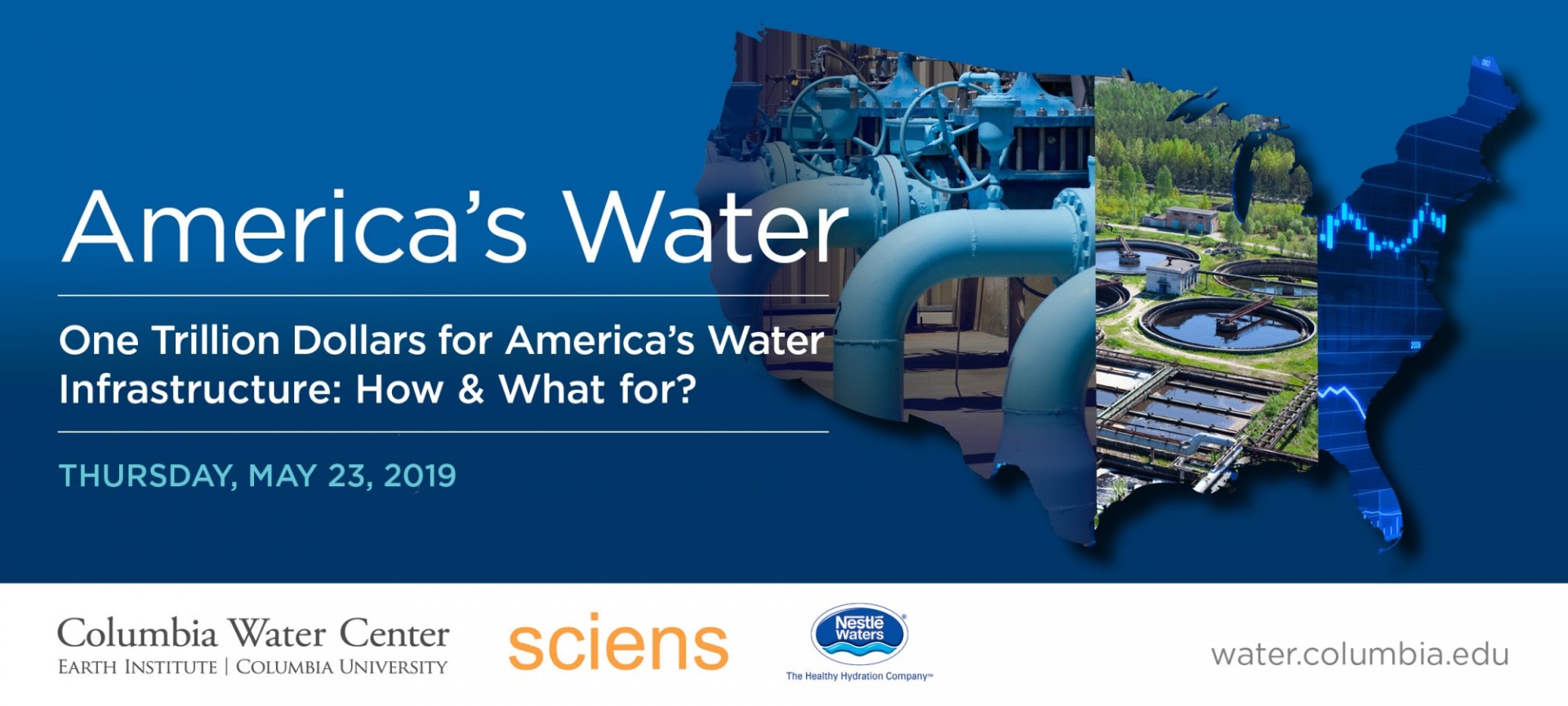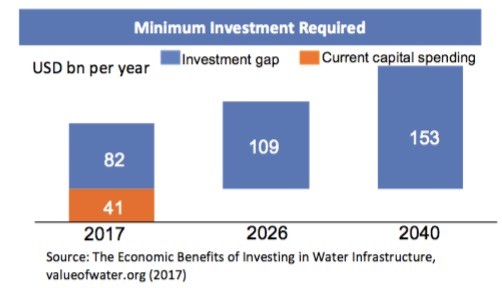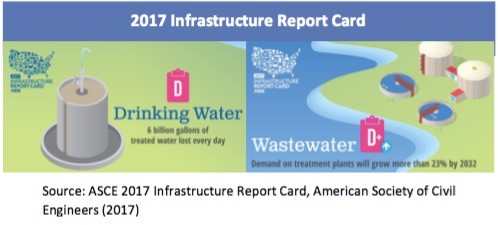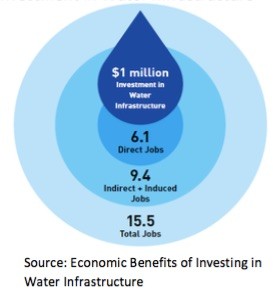The 2019 installment of Columbia Water Center’s event series once again brought together some of the country’s top water professors, professionals, financiers, regulatory and government figures to address the solutions to America’s water crisis. The program addressed several topics of critical importance; climate risks, urban water infrastructure, emerging technologies, and the food/energy/water nexus. With the aim of facilitating multidisciplinary collaboration and coordination, leaders from the private sector were invited to provide perspectives from financial institutions on how to best deploy capital to solve the water crisis.

Introduction & Morning Keynote
Professor Upmanu Lall, Director of Columbia Water Center, began the conference by setting a collective goal, “The US should be a beacon”. Local communities across the USA face a major challenge of aging infrastructure that is compounded by increasing climate variability and extremes. Water and wastewater services have significantly deteriorated. These are global challenges. Technical, financial and governance innovation in the USA would provide a global road map.
Mayor Lionel Johnson of St. Gabriel, Louisiana emphasized that government, and specifically local governments are eager to be involved in the conversation, “We cannot live in silos, we have to bring all facets together.” As co-chairman of the Mississippi River Cities and Towns Initiative, Mayor Johnson provided an overview of some specific water challenges faced by communities along the Mississippi River system, including access, flooding, and contamination, as well as challenges attracting private investments in smaller community water systems. Mayor Johnson stressed that, “Water is a vital part of our economy. We need to rethink the way that we view, use and talk about water.”

Water Problems
Water and Energy Transition
Ms. Christina Copeland (Senior Manager, Water Security, CDP) moderated a panel of two water industry veterans, Mr. Dustin Brownlow (Co-Founder & CEO, Antelope Water Management) and Ms. Jill Cooper (Senior Principal Consultant, Geosyntec Consultants), who discussed the energy transition and unfolding decarbonization which requires new solutions to ensure sustainable development is achieved without sacrificing local water resources. The panelists also discussed how companies such as Antelope and Geosyntec are leveraging new technologies and processes to increase efficiency and lower freshwater usage in mining and the oil & gas sectors as part of the energy transition.
The Outlook for Water Infrastructure
One of the key themes of the conference was discussed in the morning’s second panel, moderated by Mr. Damian Georgino (Senior Counsel, Norton Rose Fulbright). The panelists discussed new financing solutions which are needed to meet the funding gap for water to deliver climate resilient infrastructure for urban and rural areas. Increased infrastructure spending and clean water have bi-partisan and public support, and a wave of capital spending could be deployed in this space over the coming decade. Some of the key take-aways: In order to solve the trillion-dollar infrastructure issues in water, private and public entities MUST work together. Water systems must evolve how they operate by modernizing systems, processes, and technology. The fragmentation of water infrastructure could be improved with connectivity of actionable data, which would drive sustainable results and outcomes.

Keynote
Tom Rooney (Chairman, CSWR) and Zachary Sadow (Co-Founder and CFO, Antelope Water Management) engaged in a conversation about the multi-faceted challenges facing water infrastructure globally, drawing from Mr. Rooney’s extensive experience spanning industry, government, and finance. Today, Mr. Rooney advises on some of the most complex water challenges and has joined Sciens Capital in its efforts to revitalize small, stranded utilities. Some of the key takeaways included Mr. Rooney’s thoughts on the value versus the price of water, as well as his articulating the importance of the integration of new technologies with fresh infrastructure investments.
Mr. Rooney sees the disconnect of the value and price of water as stemming from a broken narrative of the perceived costs and benefits of water. In addition to the health benefits, the economic benefits associated with a community, city, or country’s ability to grow and facilitate a dynamic economic environment can often come down to its ability to provide ample clean water supplies. Often, the value, cost, and price disconnect associated with this challenge is not understood by the public, and not reinforced by government officials. Mr. Rooney emphasized the importance of effective communication and collaboration, “Between educators, politicians and thought leaders, we need to bring together these disconnects of how we discuss water. That’s when you’re going to see some momentum in the water area.”
Importantly for the large investment constituency at the conference, Mr. Rooney believes there are substantial differences in how government officials and financial markets view investing in water, despite both potentially benefiting from significant pent-up demand and a large total addressable market. He believes the challenge is enabling civic leaders to better educate the public on the cost and value of water in a way that encourages the financial sector to bring the technology and investment, despite various recent high-profile negative investment outcomes in the water space. Unfortunately, Mr. Rooney believes this continued disconnect is forcing private capital to remain on the sideline.
To address this challenge, Mr. Rooney believes municipal leaders should stand down from feeling they are under political pressure and allow for the deployment of new technology and infrastructure. Short political cycles coupled with long investment horizons leads many municipal leaders to prefer to be left in the dark when it comes to their extent of knowledge of the state of water infrastructure. Mr. Rooney believes Artificial Intelligence and big data represent major potential, particularly when paired with infrastructure upgrades. Combining these technologies with mapping platforms and sensing capabilities could have sizable economic and health benefits, including the potential to predict early epidemic outbreaks and stem non-revenue water.

The Solution
Water Solutions for Utilities and Industry
Sucharita Dasa (Director of Investment Banking, Barclays) facilitated a lively conversation about new technologies and processes which are being developed to improve water efficiencies for utilities and in the industrial sector. Mr. Patrick Decker (President & CEO, Xylem), Mr. Ed Clerico (CEO Emeritus, Natural Systems Utilities), and Mr. Christopher Mann (Partner, Sullivan & Cromwell, LLP), discussed rising consumer awareness of the dire state of the country’s infrastructure and the need to further educate consumers on the value of wastewater treatment, particularly recycling. One of the major takeaways from this panel was the passion, vision and conviction these leaders use to drive their companies to the forefront of water innovation.
Investment Opportunities in Water
Jobs Generated per $1 million of Investment in Water Infrastructure
From an allocator’s perspective, there are clear opportunities in the water space. Mr. Alexander Loucopoulos (Partner, Sciens Capital) gave an overview of what investors in water are looking at, what criteria they use, and where investors see the current opportunity set. For example, investment in water has historically been categorized as either in Infrastructure and/or water technology. The panelists discussed how there are more opportunities created in both middle market and in the part of the value chain that unlocks technologies and helps scale and commercialize these opportunities. Mr. Loucopoulos framed it well when he said, “I don’t see a $1 trillion problem, I see a multi-trillion-dollar solution.”
Water & Venture Capital
Mr. Mark Kropliak (Former General Counsel, Aqua America) moderated a panel of energetic entrepreneurs in the day’s final panel. Water remains one of the most underfunded and slowest sectors in terms of technological adoption. The panelists, all CEOs and co-founders of private start-ups with new offerings, discussed how their businesses are disrupting the water delivery model. Maher Damak (CEO, Infinite Cooling), Bessie Schwarz (Co-founder, Cloud to Street), and Daniel Zilante, (CEO, Zilper Trenchless) shared insights on the road to market adoption from capitalization.
Two of the panelists came to the conference from MIT, having both just won awards at the prestigious MIT $100k Entrepreneurship Competition. Clearly water, technology and innovation are beginning to be front and center amongst the top engineering and finance minds. One of the key take-aways: water startups need to focus on the unit economics in order to become sustainable companies.
Columbia Water Center thanks all the moderators, panelists and attendees who participated in this stimulating conference and helped keep the conversation moving forward. We are glad to provide a platform for collective action, and sharing examples of success and failure, as innovators explore how to meet the challenge in different ways. Our collective basic and applied research can help build a transition for the 21st century. Support and engagement from the industry and governments is much appreciated.
The Columbia Water Center was greatly assisted by this year’s major sponsor, Sciens Capital, a New York based private equity firm whose goal is to fix water infrastructure in the US.
